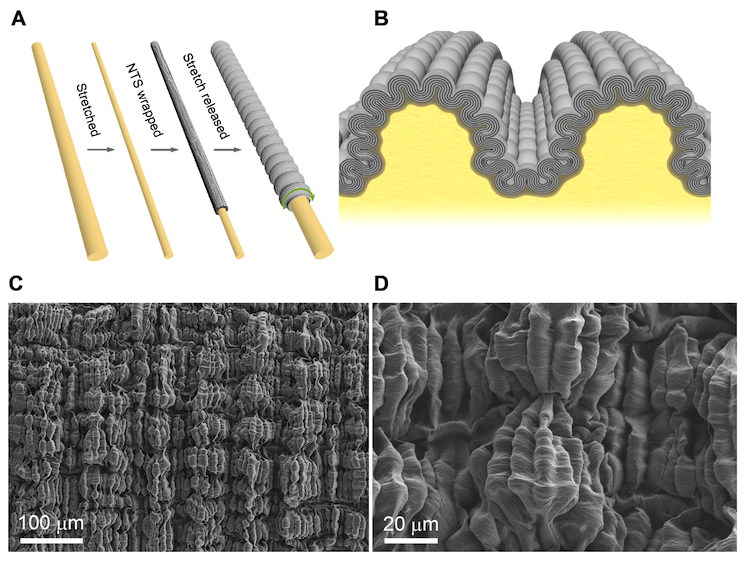The electrical conductivity of conducting fibres normally decreases when they are highly stretched but researchers at the University of Texas at Dallas have now created superelastic fibres based on carbon nanotubes that do not suffer from this problem. Indeed, the conductivity of the new fibres actually increases by 121-fold when they are stretched to over 11 times their original length, and such extreme stretch results in only a 5% change in their resistance. The fibres might be used in a host of flexible electronics applications, including smart textiles, artificial muscles for robots, interconnects for elastic circuits, strain sensors and failure-free pacemaker leads to name but a few.
Buckling occurs in 2D
When conventional conducting fibres are stretched and become longer, their cross-sectional area becomes smaller. This restricts the flow of electrons through the material and so increases its electrical resistance.
The new fibres, made by a team led by Ray Baughman, are assembled by wrapping electrically conducting sheets of carbon nanotubes around a long rubber core made of a plasticized styrene-(ethylene-butylene)-styrene (SEBS) co-polymer. They differ from their conventional counterparts in that the carbon nanotube sheets form periodic short and long buckles when the rubber wrapped around them relaxes after being stretched. It is this buckling that allows the fibre to be repeatedly stretched and released. The fibres maintain their electrical conductance even when stretched by large amounts because electrons can travel over such a buckled sheath as easily as they can traverse a straight one, explains Baughman.
The buckles not only form along a fibres length, but also around its circumference, adds team member and first author of this study, Zunfeng Liu. The fact that the buckling occurs in two dimensions means that the nanotubes do not misalign along the rubber core, which allows the sheath-core fibre to retain a nearly constant electrical resistance even during stretching.
To test their fibres, the researchers added a thin overcoat of rubber to them and then another carbon nanotube sheath. They then made capacitors from these more complicated structures, in which the buckled nanotube sheets act as electrodes and the thin rubber layer is a dielectric. The capacitance of these devices changes by 860% when the fibre is stretched to 950% of its original length. No other material-based strain sensor can operate over nearly as large a strain range, says Liu.
Applications include smart textiles but not only
And that is not all: the conducting fibres can also be fabricated in varying diameters – from around 150 microns to much larger depending on the size of the rubber core. The fibres can be bundled together like yarn or rope, says team member Nan Jiang, which decreases resistance even further.
The most obvious application for these fibres is in smart textiles that people can wear, but other potential applications include interconnects for elastic circuits, strain sensors and failure-free pacemaker leads that can stretch. Twisting the double-sheath fibres also produces torsional artificial muscles and these structures could be used to rotate mirrors in optical circuits or to pump fluids in medical devices, for example, adds team member Carter Haines.

